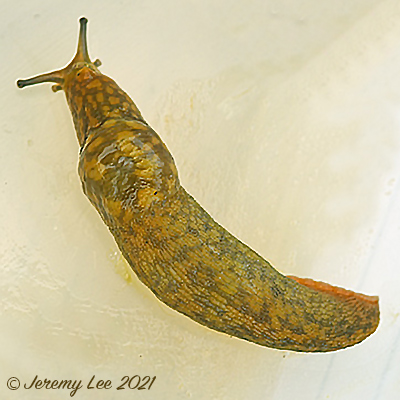
 |
|
Scientific Classifications explained » Amphibians » Ants » Aphids » Bees » Beetles » Birds » Bugs » Butterflies » Caterpillars » Damselflies » Dragonflies » Earwigs » Flies » Frog/Leafhoppers » Fungi » Galls » Grasshoppers » Harvestmen » Hoverflies » Lacewings » Ladybirds » Leaf Mines » Lichens » Mammals » Millipedes » Mosses » Moths » Sawflies » Slugs » Snails » Spiders » Trees » Wasps » Wild Flowers » Woodlice |
UK Nature > Slugs > Limacus maculatus

Scientific Name: Limacus maculatus Common Name: Green Cellar Slug Limacus maculatus, or the Green Cellar Slug as it is commonly known, can grow up to 13 cm in length. A medium to large slug (length: 7-13cm). They can be separated from the similar-looking, Yellow Cellar Slug using a few quick tricks: this slug is generally darker in its complexion; it is a dark, yellow-green colour; a yellow stripe on the tail is dramatically reduced or absent; the spots of the Green Cellar Slug are larger; the tentacles are grey to grey-blue; its mucous trail is clear, sometimes with a tinge of yellow-orange; the young slugs appear darker with less mottling/ spots. They're frequent garden residents, often being found beneath logs, stones and especially in compost bins. They're expanding their range, and it's been proposed they're out-competing, or interbreeding with the Yellow Cellar Slug. |
|

https://www.uknature.co.uk is a website dedicated to showing the immense diversity of UK nature and wildlife. Our vast range of habitats, from lowland arable to snow covered mountains, from storm-ravaged coastlines to peaceful inland freshwater lakes and rivers, from dry, sandy heaths to deciduous and coniferous forests, all these habitats contribute to the abundance of UK nature. We have wild birds in huge numbers either residing or visiting our shores (597 recorded species as at July 2013) and we must also not forget the humble back garden with its grass lawns, flower beds filled with nectar rich flowers, shrubs and trees, all designed to attract huge numbers of insects such as bees, moths, butterflies and hoverflies; and finally the small ponds which provide safe havens for frogs, toads, newts and even slow worms and grass snakes. www.uknature.co.uk is the showcase for my personal passion, photographing uknature in all its glory. I sincerely hope you all enjoy the fruits of my labours. This site and all images contained therein is © Jeremy Lee 2004 - 2021. All Rights Reserved. Site design by Jeremy Lee. Site development & IT Support by Stuart Lee. |